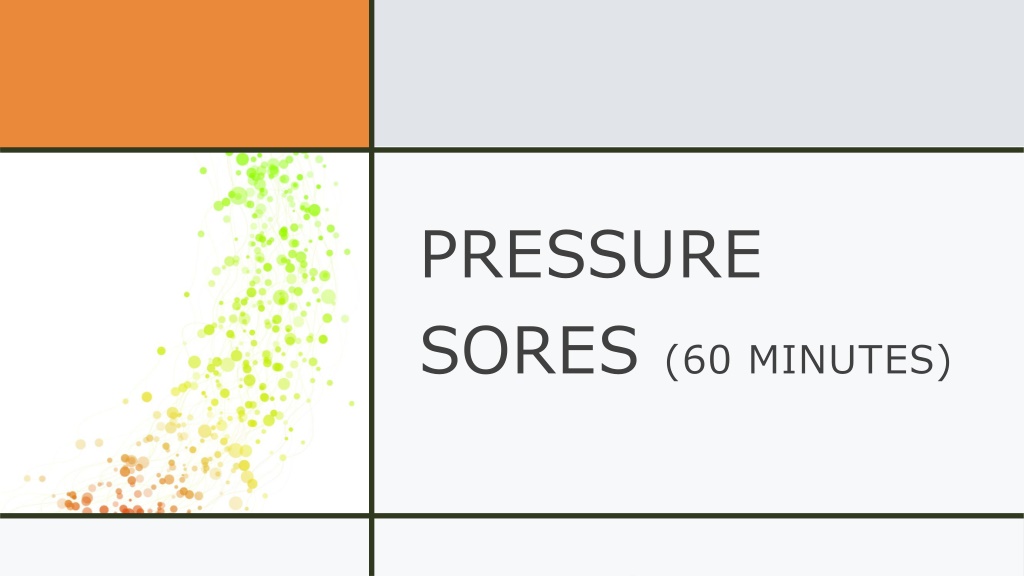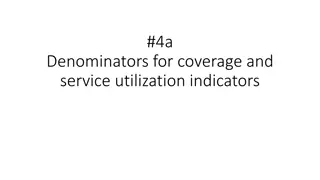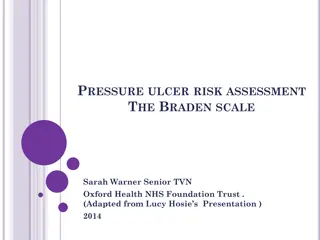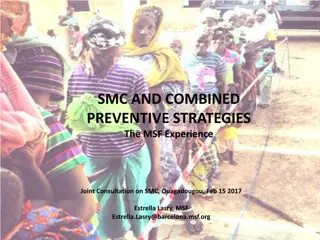Understanding Pressure Sores and Preventive Interventions for Bedridden Patients
Pressure sores, also known as pressure ulcers, are localized areas of tissue necrosis caused by prolonged pressure on skin and soft tissues. This can lead to serious complications, especially in bedridden patients like a 76-year-old man following a stroke. Preventive interventions include relieving pressure, maintaining skin hygiene, optimizing nutrition, and regular repositioning. Recognizing risk factors like age, incontinence, and circulation issues is crucial to prevent the development of pressure sores.
Download Presentation

Please find below an Image/Link to download the presentation.
The content on the website is provided AS IS for your information and personal use only. It may not be sold, licensed, or shared on other websites without obtaining consent from the author. Download presentation by click this link. If you encounter any issues during the download, it is possible that the publisher has removed the file from their server.
E N D
Presentation Transcript
PRESSURE SORES (60 MINUTES)
If a patient develops bedsore, its generally not the fault of the disease, but of the nursing - Florence Nightingale 1. Do you agree with this statement? And why? Opinion Post your response in the Chat Box/ unmute the microphone and speak
Discussion A 76-year-old man is bedridden following a major stroke. He is unconscious and is on nasogastric feeding and has urine and faecal incontinence. Discuss the situation and suggest interventions to prevent bedsores Discuss in groups (10 minutes). Report back ( 5 minutes)
Pressure-induced skin and soft tissue injury (Pressure Sores) are localized areas of tissue necrosis that tend to occur when soft tissue is compressed between a bony prominence and an external surface for a prolonged period. Pressure- induced skin and soft tissue injury The sore is caused by constant, unrelieved pressure on the skin and underlying tissue. The pressure comes from outside the body.
Pathophysiology Pressure slows the blood flow to an area which leads to tissue death Friction and shear can add to the problem
Pressure: Restriction of blood flow when skin and the underlying tissues are trapped between bone and a hard surface Causative Factors - Extrinsic Friction: Resistance to the skin when body sliding or rolling over another surface it is in contact with. Shear: Occurs when skin moves in one direction, and the underlying bone moves in another; e.g. sliding down in a bed or chair. Strain: Tissue deformation in response to pressure
Risk Factors - Intrinsic Age. Older adults have thinner skin, less natural cushioning over bones and poor nutrition Lack of pain perception. Eg, Spinal cord injuries Malnutrition Urinary or faecal incontinence. Moist skin can break down easily. Bacteria from faecal matter can cause infections Diseases conditions affecting circulation (diabetes mellitus, vascular diseases) / Smoking (Nicotine impairs circulation and reduces the amount of oxygen in the blood) Decreased mental awareness by disease, trauma or medications
PRESSURE POINTS
Pressure Ulcer - Stages Pressure ulcers are graded/ staged as Stage 1, Stage 2, Stage 3, and Stage 4 to indicate the amount of tissue damage
Pressure Sore Stage 1 Most superficial An area of skin that is noticeably different from the surrounding area. It may look red, and the redness is not blanchable (does not fade when the skin is pressed and released) May be painful
Pressure Sore Stage 2 Superficial ulcer as blister or abrasion Epidermis damaged Dermis is exposed No granulation tissue, no slough, and no eschar
Pressure Sore Stage 3 The full thickness of the skin is lost The subcutaneous tissue is exposed The wound appears as a deep crater The granulation tissue, slough, or eschar may be present, making it difficult to stage
Pressure Sore Stage 4 The muscles, bones, and tendons lay exposed The ulcer is a deep crater The granulation tissue, slough, or eschar may be present making it difficult to stage
Pressure Sore Unstagable To stage a pressure sore, one needs to visualise the base of the wound. When the base of the wound is covered by slough or eschar, then the pressure sore is called an unstageable pressure sore. Once the slough is removed the pressure sore is usually stage 3 or stage 4
Regular Position change: Support surfaces Ensure adequate Nutrition Manage incontinence Regular Exercise Ensure Hygiene Avoid vigorous massages on the bony prominence and reddened areas Regular assessment for skin changes. Control infection Prevention of Pressure Sores
Periodic and regular position change is crucial to protect the patient from developing pressure sores and to promote healing for the patient who has already developed a pressure sore, Position should be changed every 2 hours for the lying patient Position must be changed every 15 minutes if the patient is sitting/confined to a wheelchair Position Change
Air bed and waterbed to reduce the pressure exerted on the bony prominences Not a substitute for regular position changes. Gloves filled with water can be placed below the Achilles tendon to prevent pressure injury at the heel. Ensure that the bedding is wrinkle-free to prevent superficial skin abrasions. Support Surfaces
Ensure food intake with 30 to 35 Cal/kg/day energy and 1.5g/kg/day of protein Adequate Nutrition
Regularise bowel routine Ensure proper drainage of urine Manage incontinence
Active and/ or passive exercise to help in maintain muscle mass and promote circulation Exercise significantly reduces the risk of developing pressure sores. Regular Exercise
Maintain the skin clean and dry Use emollients regularly to reduce friction exerted on the skin. Daily back care and bed bath with warm water to promote circulation Avoid vigorous massages on the bony prominence and reddened areas Hygiene
Check the skin every time someone helps the patient to the toilet, dress, bathe, transfer, and turn a bedridden patient. Look for areas of skin noticeably different from the surrounding area A suspicious area may feel "spongy / "raised / warmer/ colder than the surrounding areas Regular assessment for skin changes
The diagnosis of wound infection is a clinical diagnosis and not a microbiological diagnosis as almost all wounds are colonized by bacteria. Signs of wound infection. Erythema around the wound Increased warmth Increased tenderness Foul-smelling, thick, purulent discharge Fever Diagnose infection early
Local application of Metronidazole (powder/gel). Daily dressing the bedsore with saline and metronidazole tablets crushed into powder (or gauze soaked in metronidazole IV solution) will be effective Works effectively against foul smell producing anaerobic organisms. Infections























